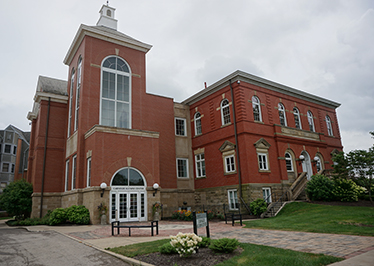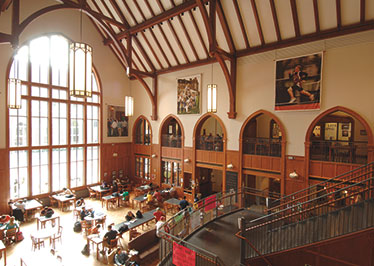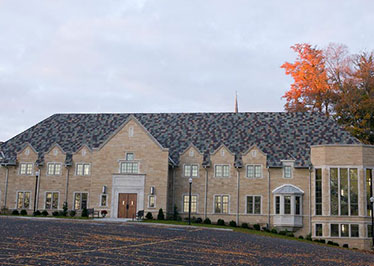Final in a series on the iconic architecture of campus by Alyssa (Jackson ’19) Bootsma
For Grove City College, the turn of the 21st century was marked by record fundraising, renovations and a building boom.
Nineteen-ninety-four saw the inauguration of a different kind of infrastructure project under the presidency of Dr. Jerry H. Combee’s (1991 to 1995.) The laptop computer program provided each new freshman a laptop and printer for their college years and to keep after graduation. Over time it created a system of digital unity, with everyone on campus on the same technological page, that continues today.
The College launched two capital campaigns during the presidencies of Dr. John H. Moore and Dr. Richard G. Jewell ’67. These massive fundraising efforts were a new endeavor for the College. The first campaign, “Change and Commitment,” was launched in the late 90s. “We are blessed to be stewards of the living legacy that is Grove City College,” Moore, who served from 1996-2003, said.
Jewell, then a member of the Board of Trustees, was key to the effort as co-chair of that campaign and head of the advancement committee. Later, as president from 2003 to 2013, he would oversee the “Grove City Matters” campaign. Of fundraising, Jewell noted: “As General Patton said about war, God help me I love it so.”
The goal of the campaigns was to raise funds for brick and mortar, scholarships and various college programs like the Institute for Faith and Freedom (formerly the Center for Vision and Values) and the Center for Entrepreneurship + Innovation. According to Jewell, the campaigns were incredibly successful because of this diversification. College leaders had a vision of developing the campus more, focusing on updating and beautifying facilities, which was rooted in Joseph Newton Pew’s dictate to “Make the campus beautiful for that, too, is an education.”
“Change and Commitment” sought to raise $60 million, two-thirds of which was earmarked for campus improvements. By the end of the campaign in 2007, the final count was $69 million.
 A new academic building ($20 million), a new student activities center ($7.5 million), expansion of the Pew Fine Arts Center ($4.5 million) and renovation of Carnegie Hall ($8 million) were all covered.
A new academic building ($20 million), a new student activities center ($7.5 million), expansion of the Pew Fine Arts Center ($4.5 million) and renovation of Carnegie Hall ($8 million) were all covered.
The first phase of the construction projects started in the spring of 2000, with the groundbreaking of the Hall of Arts and Letters, which would replace Calderwood Hall. Before the new academic building was finished, updates to the Pew Fine Arts Center were finalized in 2002. Additions to the music and art building included additional classrooms, practice rooms, the 188-seat Arnold Recital Hall and the Stauffer Lounge.
The Hall of Arts and Letters created more classroom and faculty office space and study areas for students. It included Sticht Lecture Hall, a spacious auditorium named in honor of Board Chair J. Paul Sticht ‘39. The additional space helped accommodate additional faculty and students as part of the College’s plans. The Hall of Arts and Letters and other new construction in this era emulated the Collegiate Gothic style of many existing buildings.
According to Jewell, his favorite addition was the Carnegie Alumni Center. After nearly 100 years, the former Carnegie Music Hall, which had served a variety of purposes over the years, was in bad shape. The auditorium on the second floor had been condemned and the building was falling apart. “We made a silk purse out of a sow’s ear and when we were done, we had a tremendous asset,” Jewell said. Not only was there space for the Alumni and Advancement office to grow, but also there was space for the Archive, which was established in 2012 by Hilary (Lewis ’09) Walczak, the College’s Marketing and Communications office and the Collonade, which hosts meetings, formal dinners and banquets.
 Work on Carnegie, Thorn Field and the later addition of Colonial Hall Apartments were motivated by a “back to the future” mindset, Jewell said, bringing a new focus to lower campus where the whole of the college used to be. The football field got a makeover in 2006 with artificial turf, a new track and lights. These improvements helped to establish and enhance the club and intramural sports on campus, earning the College national recognition as one of the top schools in the nation for intramural sports.
Work on Carnegie, Thorn Field and the later addition of Colonial Hall Apartments were motivated by a “back to the future” mindset, Jewell said, bringing a new focus to lower campus where the whole of the college used to be. The football field got a makeover in 2006 with artificial turf, a new track and lights. These improvements helped to establish and enhance the club and intramural sports on campus, earning the College national recognition as one of the top schools in the nation for intramural sports.
In September of 2000, the McMillan Press Box had been added, overlooking the football field and providing an enclosed space for a media room, President’s box, coach’s boxes and a concession stand. It is named in honor of Dr. Donald “Doc” McMillan ‘32 in recognition of his dedication to Grove City College as an alumnus and athletic recruiter.
Behind the field, the College built the Colonial Hall Apartments in 2006 near where the original Colonial Hall used to stand until 1981. “We were turning away very qualified students for lack of residence hall space,” Jewell said. An additional benefit of providing 188 more student beds would be the ability to pay off the cost of the apartments, which the tuition money of those students did for the next eight years. The apartments are the newest addition to residential living and are a 15-minute walk to the academic buildings on upper campus. According to Jewell, the apartments provided students with “A step up before they stepped out.” In addition, the student body increased in size by 10 percent as a result.
Walczak remembers this era well, as she started her freshman year in 2005. “I remember my friends who lived in the apartments the first year. I couldn’t wait to be a senior and live there.”
If projects were not covered under campaign money, alumni and friends would make sure it would be properly paid for. “Every time we found something that would enhance us, we would go and find somebody to help pay for it,” Jewell said.
Two of the era’s signature buildings bear the names of generous supporters who also provided essential leadership on the College’s Board of Trustees. Jewell said he loved the idea of naming facilities to honor alumni and friends of the College who contributed.
 In January 2007, Edward D. ’78 and Lynn Breen ’78 gave a generous donation to close the $69 million Change and Commitment Campaign. In recognition, the new Student Activities Center built in 2004 was named in their honor and rededicated as the Breen Student Union in May 2007. Breen was elected Chair of the Board of Trustees in May after years of service on the Board. Breen has enjoyed a successful career in business and currently serves as chairman and CEO of DuPont de Nemours, Inc.
In January 2007, Edward D. ’78 and Lynn Breen ’78 gave a generous donation to close the $69 million Change and Commitment Campaign. In recognition, the new Student Activities Center built in 2004 was named in their honor and rededicated as the Breen Student Union in May 2007. Breen was elected Chair of the Board of Trustees in May after years of service on the Board. Breen has enjoyed a successful career in business and currently serves as chairman and CEO of DuPont de Nemours, Inc.
Ground was broken for a Christian activities building in 2011, with a significant contribution the Grove City Matters campaign from the family of David Rathburn ’79. Rathburn, who served as Chairman of the Board from 2003 to 2020, was a key leader during the 2000s building boom. The building is named Rathburn Hall in recognition. Inside, the Morledge Great Room honors former dean of the chapel, the Rev. Dr. Richard A. Morledge '54 (dean from 1984 to 1999). Rathburn Hall also houses Chapel Ministries offices, meeting rooms, prayers rooms and space for events and dinners.
 Grove City Matters raised a record $90 million for the new construction, campus updates, scholarships and the centers by the time it wrapped up in 2014 under the presidency of Jewell’s successor, Paul J. McNulty ’80.
Grove City Matters raised a record $90 million for the new construction, campus updates, scholarships and the centers by the time it wrapped up in 2014 under the presidency of Jewell’s successor, Paul J. McNulty ’80.
The biggest project it funded was STEM Hall, which was dedicated on Sept. 19, 2013. The science, technology, engineering and mathematics facility, built in the shadow of Rockwell Hall, features state-of-the-art laboratory, classroom and office spaces as well as a vivarium, conference space and study areas.
Also in the 2000s, the nationally ranked Career Services Office was moved into space that formerly housed the PLC. “The retrofit of that space made it incredibly professional,” Jewell said. Additionally, Hicks and Map cafeterias underwent refurbishing under the presidency of Jewell, including the popular addition of air conditioning in both dining halls.
Over nearly a century and half, Grove City College grew from a few rooms near Broad Street to a 180-acre learning and living community that is home to a community of 2,400 students and the faculty and staff who work with them to fulfill the College’s historic mission.
It is an undeniably beautiful campus and strikes most visitors as a classic environment. McNulty recalls taking guest Brit Hume, senior political analyst for FOX News channel, on a tour. When they reached the bottom of the Quad and looked up at Rockwell, Hume said: “That's as classic a collegiate picture as you could find anywhere."
As the College looks to the future, keeping the campus beautiful will be a priority. "The next decade for the College will be a combination of preserving the old and iconic old,” McNulty said. “Rockwell, Ketler, Hopeman, and building the new and functional: a field house and more STEM space,” McNulty said.
"There is no question that the physical beauty of our campus is a valuable distinctive in the increasingly competitive landscape of higher education,” McNulty said. "But for GCC, the splendor of the campus grounds is more than a competitive advantage. It's a core value. We believe and are committed to supporting the truth that place matters. God made a world that reflects his glory and men and women in his image. There's a vital connection between human flourishing and beauty."
Back in the beginning, Joseph Newton Pew and founders of the college recognized the importance of this vital connection. Throughout the decades and across centuries of growth and change, the campus beauty has been a stalwart. Because of the dedicated leaders the College has been blessed with, it has become one of the most beautiful campuses in the country, not only for its physical beauty, but for its commitment to faithfulness, excellence, community, stewardship and independence. And it is these five pillars that will keep Grove City College beautiful for the ages.
Read the Building a Legacy Series
Part 1: Campus buildings tell College’s story
Part 2: Creating a campus in the community
Part 3: Growth in the midst of the Depression
Part 4: Weathering the war and completing the plan
Part 5: The Surge of the 60s, 70s and 80s